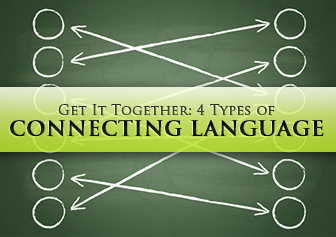Making connections.
It’s a good idea in the work place, but it’s absolutely essential when you are in the classroom. In math class, a simple plus sign is all that’s needed, but in the language classroom, things are a little more complicated. Connections in English can happen between independent sentences. Words such as also, in addition and plus will link an idea in one sentence to an idea in another sentence. But connections can happen within a sentence as well. For these types of connections, English speakers generally use one of four types of connecting language.

How We Connect Ideas in English
-
1
Coordinating Conjunctions
The first type of connecting language in English are coordinate conjunctions. These familiar words include and, but, or and nor. These little words connect words, groups of words, sentences or groups of sentences. For coordinating conjunctions, the words or sentences are on the same level, that is, they are of equal value.
And is an inclusive connector – it creates a positive connection between two ideas, people or things.
I play tennis, and I study physics.
But, on the other hand, shows contrast between ideas, people or things.
I play tennis, but I do not study physics.
Or communicates a choice between two elements.
Do you play tennis, or do you study physics?
Nor shows negative inclusion, that is, neither is true.
I don’t play tennis, nor do I study physics.
-
2
Correlative Conjunctions
Correlative conjunctions are pairs of words that show relationships between subjects and objects in a sentence. They include both…and, not only…but also, either…or, and neither…nor. Like coordinate conjunctions, correlative conjunctions connect ideas that are of equal value.
Both…and shows a similarity or connection between ideas.
Both Jake and Mary play tennis for exercise.
Not only…but also shows that a subject has two distinct qualities.
Not only does Jake play tennis, but he also studies physics.
Either…or communicates a choice between two elements.
Either Mary can play tennis or she can study physics. She doesn’t have time for both.
Neither…nor shows a negative similarity or connection between ideas.
Neither Mary nor Jake plays tennis on Sundays.
-
3
Subordinating Conjunctions
Subordinating conjunctions connect two ideas that are not of equal footing. One idea is subordinate to the other. When a dependent clause is connected to an independent clause with a subordinating conjunction, the result is a complex sentence. English has over thirty common subordinate conjunctions. Some of the most familiar are if, because, since, so that, and when. Subordinating conjunctions can be divided into eight basic categories.
Place: She plays tennis wherever she travels.
Time: She feels tired after she plays tennis.
Manner: She dresses however she wants.
Cause/Reason: She does this because she doesn’t care about style.
Purpose: She practices so she can get better.
Result: She plays so that she will stay healthy.
Condition: She practices even if it is raining.
Substantive: Who can know whether she is right?
-
4
Relative Pronouns
Relative pronouns also connect a dependent clause to an independent clause, resulting in a complex sentence. When relative pronouns are used, the dependent clause gives more information about something or someone in the independent clause. Relative pronouns include who, whose, where, when, which and that.
Who relates information about a person.
Jake is someone who likes to exercise.
Whose shows a possessive relationships.
Jake is an athlete whose body shows his efforts.
Where indicates a place.
The park is where the tennis courts are.
When indicates a time.
After work is when he likes to play.
Which is used for things. That is used for both people and things.
Tennis is a sport which (that) will keep you healthy.
As you can see, making connections in the English language can be complicated and confusing for ESL students. If your students can master these four types of connecting language, however, they will be successful communicators.
What types of connectors do your students most struggle with?
P.S. If you enjoyed this article, please help spread it by clicking one of those sharing buttons below. And if you are interested in more, you should follow our Facebook page where we share more about creative, non-boring ways to teach English.







